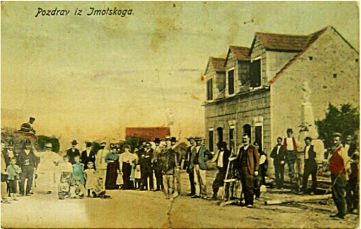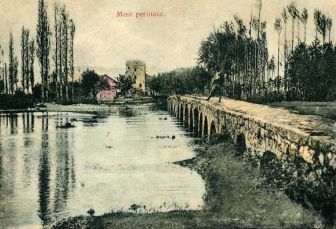| |
|||||||||||||||
| |
|||||||||||||||
| |
|||||||||||||||
| The history of the region was very turbulent and bloody. There were several distinct periods that are covered in this page. Table of
contents
Illyrians
Romans Christian religion Croats Hungarian kings Bogumils Imotski in old records Turkish occupation Venetia 1717-1797 Austria 1797-1806 France 1806-1813 Austria 1814-1918
It has been established that the region of
Imotski County has been populated in the Neolithic age.
There are many archeological findings of stone axes and sledge hammers
in Vinjani and Grabovac as well an urn from Slivno dating from 1500 B.C. The history of the region is still full of unresolved questions. The Illyrians were the first inhabitants of the greater region occupied by the former Yugoslavian state, but most of the data are coming from Greek and then Roman sources. The old Greeks have colonized the fertile coastal regions and a few islands like Vis (Issa) and Hvar (Pharos). Discovery of their coins and few art crafts along the old Imotski county roads suggests they were trading there. It is most likely they were coming from the direction of Vid (Narona).
Illyrians were
good warriors and they were good in forcing nearby tribes to pay
taxes. Romans clashed
with the Illyrians in 230 B.C. when the Illyrian started pirating Greek
and Roman merchant ships. There were periods of hostility and
peace between them so it took the might Roman war machine several
centuries to conquer the war oriented Illyrians tribes.
Daors, as a smallest tribe made a pact with Romans, endured
harassment's
from Dalmatae , and eventually helped the Romans to their quests to
pacify the Dalmatae.
The road building "viae millitares" to facilitate the future conquests started with Augustus and it was largely finished with Tiberius and Claudius. They have reused in part the road system build by Illyrians.
The main road connecting Salona = Solin,
Tilurio = Trilj, Billubio = Lokvicici, Ad Novas = Runović, Ad Fusciana
= Rasici, Bigeste = Humac, and Narona = Vid is passing though Imotski
county. The other road with some significance is Jader =
Zadar, Tragurio =
Trogir, Salona = Solin, Epetio = Stobreč,
Inarona = Makarska, and Oneo = Omiš.
In addition to the Salona - Narona road passing through Imotski county
there were three auxiliary Roman roads:
The Christian
religion appeared on the
coastal regions at the beginning
of the first two centuries and started making inroads towards the
inland. Practicing Christian religion was forbidden at that time.
Emperor Diocletian (284-305) was famous for his persecution of
Christian believers. Eventually the emperors gave in and with Milan
edict in 313 practicing Christian faith is allowed. There were two
church "sabor" in Salona in 530 and 533. Sarsenterum, near today's
Aržano become the Bishop's seat in charge of the whole Imotski county,
Novae being the more eastern point. The other well known place
mentions around that time is Montanense ( in Croatian translation "za
gvozdom" or today's Zagvozd) that is part of Makarska diocese. The most
important church from that time, built in late 5th century was located
in Dikovača (Zmijavci). It was discovered in 1897/98 by Don Ivan
Tonković. Croats built their basilica in
the ninth century there on the
Roman church ruins. The basilica had attached baptistery with
baptismal font
in a shape of cross. The basilica also had one baptismal font of
smaller proportions, what makes this basilica a rare structure with
two baptisteries. It had a relief decoration showing a bible motif,
Saint Daniel in fight with lions on its altar. The other two
important churches from that time were located in Cista
and in Proložac.
There was a
string of Croatia rulers
in the 11th century who have
managed to keep the Tomislav's Croatia largely intact, even increasing
it like Krešimir IV, but the
lack of male successor, after King Zvonimir death in 1089, led Croatia
to the Hungarian King Ladislav who was Queen Helen's brother. He
invaded Croatia north of Gvozd hills and claimed the Croatian
throne. After the initial turmoil the southern Croatian part
chose noblemen Petar as a king. Peter has managed the take care
of the ensued chaos, but he came in conflict with King Koloman
(1095-1116) of Hungary after he tried to chase the Hungarians out of
the northern Croatian parts. King Petar was killed on Gvozd hills
in 1097 and Croatia lost its independence. Only with Pacta
Conventa in 1102, Croatian noblemen recognized Hungarian King Koloman
and his successors as rulers of Croatia. Croatia has managed to
keep "de facto" the status
of a state, but
it was now ruled by Hungarian House of Arpad. There was a decline in Byzantine Empire around that time and a rise of Venetian republic that has started a power struggle with Hungarian to rule Dalmatian coast and towns. The towns had a long tradition of established local nobility and self rule. Town governing was initially modeled on the aristocratic communes of the Byzantine era, headed by priors. Under the Hungarian rule the communes saw more democratic governance that was transitioning to the emerging Italian model with independent podestás who were selected by local establishments from out of town candidates. Bela I (1131-1141) has managed to claim the whole Dalmatia, but Zadar, and a part of Bosnia and has proclaimed himself a king of those lands. He has considered those lands his vassal properties and in 1139 he gave them to his son Vladislav to rule. Around that time Hum ( central part of today's Herzegovina ) was formed. It was contested by Bosnian ban (viceroy) Stjepan Kotromanić, Hungary-Croatian king Ludovik I, and the Serbian Nemanjic dynasty. Pagania ( župas Rastok, Duvno, and Makarska ), Imotski county and parts of Serbia near upper Drina were joined to Hum around that time to form Zahumlje, but the original name Hum prevailed later on. Imotski county saw many different rulers as Hum changed hand. The Byzantine Empire under Emperor Komnen took advantage of post Bela I power struggle and had reoccupied almost the whole Balkan leaving Zadar in Hungarian and Croatian hands. The Nemanjić's were given Hum to rule and eventually have managed to get independent of Byzantine. They lost Hum after they were defeated by Croatian Herzog Andrija ( 1197-1205). It
was known that duke Domaldo from Split
got Imotski county to govern in 1210 after helping Hungarian king
Andrija
( 1205-1235) to prevent his overthrow. At that time the
Nelipić's, nobility from Sinj and Knin
started a power struggle with Domaldo
about
Imotski county. That was a time of rise of powerful Croatian
noble families who were de facto governors of their territories,
often undermining the Hungarian rulers. That state of affairs
prevailed till 1348 when king Ludovik I managed to break the power of
most important and influential Croatian nobility. Hum was not
very defined region and Imotski county was in and out frequently, often
governed by the same Nelipić family. Duke
Peter proclaimed Hum independence
sometimes after 1205, but not for long before he
yielded to Stevan The First Crowned in 1225 shortly after being
recognized
as a duke of Split. Family ties between Hungarians,
Croatian and Serbian ruling families often lead to interesting
alliances, so there are
many claims on the region ever since. In
1242 Mongols (Tartars) reached all the way to Split, but gave up on
conquering it after Kan Ogotay's death. On the way back they have
ransacked the whole region, killing everybody on their way.
Archdeacon Toma (1200-1268) from Split describes them as fearless
looking,
short with broad shoulders, having small eyes, and eating only meat and
drinking buttermilk mixed with horse blood. Andrija Nemanjić
became the ruler of Hum afterwards, but not for very
long. He was defeated by Hungarian-Croatian kings and lost Hum
forever after
that. Ludovik III (1272-1290) was slowly losing
grip on the power. so powerful Croatian count Pavao Šubić became the
first
Croatian
Ban (the king's proxy) in 1283. Pavao was also a recipient of
land gifts during the dynastic power
struggle
between House of Aprads and Angevins. By 1299 he has also ruled
Bosnia.
Soon after he appointed his son Mladen I there as a Bosnian
ban. He also
appointed his son Mladen II as a ruler of Hum, where Imotski county was
at that time. Mladen II took Bosnian ban title after the death of
Mladen I. Croatian ban Pavao has became the most powerful
Croatian ruler, still dependent on the Hungarian dynasty, after the
natural Croatian rulers in 10th century. The Šubić family
descendants later become owners of the Zrin property which gave another
noble Zrinski family, also called Šubić-Zrinski. They were very
important family
during the Croatian history. Mladen II inherited the power in
1312. In 1318 his title was "Ban of Croatia and Bosnia and
a ruler of Hum lands," but he was contested as a ruler in
Croatia and Bosnia by other nobility not being as strong as his
father. To diffuse the tension he appointed Stjepan II Kotromanić
as a Bosnian ban,
the same man who later helped Carlo Robert remove him from power.
Stjepan II Kotromanić got to rule Bosnia,
Hum, and Dalmatia from Cetina
to Dubrovnik. He even managed to take Upper Hum from Stevan
Dečanski in 1325. Imotski
become part of Hum again in
1326. The region of old Croatian zupas, including Imotski zupa
become known as Završje under Stjepan II,
so Imotski become a part of
Bosnian state for quite some time, except in Ludovik's time
(1357-1382). Serbia become very powerful state around
that
time under Dušan Mighty who wanted to
return Hum back to Serbian rule.
He was backed by Mladen III who married Dusan's sister Jelena against
king Karlo. The wars become especially intense under king Ludovik
who was
backed by Stjepan II Kotromanić.
Stjepan II penetrated into
Serbia
in 1349. Dušan Mighty retaliated by
attacking Bosnia next year,
conquering and
ransacking it, but failed to capture Bobovac, the ban's capital.
He reached all the way to Cetina, passing through Imotski. There
is a folk story, most probably true because it is found independently
in Serbia, that Dušan took 3 brothers Mrnjavčević, after being
impressed with Vukašin Mrnjavčević in a hunting
expedition, with him to
Serbia and gave them large land holdings in southeastern Serbia with
honors. Dušan retook
Hum, but lost it soon to Stjepan II, who gave it as dowry to his
sister Jelisava who become the wife of king Ludovik. Stjepan II's nephew Tvrtko took power after
Dušan's death. He was
unable to become independent from Hungarian dominance till Ludovik's
death. However, he took the Serbian part of Hum in 1374 after
Dušan's death and the collapse of Serbian
state. He ncreased his holdings
in 1376 by conquering Kotor and proclaimed himself as king of
Bosnia and Serbia soon afterwards. Ludovik ruled Croatia and
Imotski county till his death in
1382. Anarchy ensued after that because the Hungarians and
Croats were
unwilling to submit to his wife Jelisaveta and daughter Maria
rule. Bosnian king Tvrtko took advantage of the turmoil and
became the ruler of the regions in 1388. His heirs were very
ineffectual,
and the mighty nobility became de facto the rulers. Imotski
county region changed hands among Bosnian nobility, king Zigmund, and
Neapolitan king Ladislav. Ladislav is infamous for selling the
rights of Dalmatia for hundred thousand ducats to Venetians in 1409,
after realizing that he is losing control of it. In 1437,
Hungarian King Sigismund settled all the controversies about Dalmatia
with Venetians for ten thousand ducats. During the Stjepan II Kotromanić rule Bosnian heretics (called also Patarins, Bogumils in Croatian) appeared in Imotski county at the end of the 12th century. Stjepan II relied on Bogumils to consolidate his rule. Christian clergy, like bishop from Makarska, for example were forced to go to Omiš. Heretics form both Serbia and Croatia found Bosnia as a sanctuary, but with constant power struggle between larger countries bordering Bosnia Bosnian even the rulers often renounced the heresy. It is unclear how the heretics appeared. One theory claims that the local clergy did not know Latin, so their interpretation were adjusted to the local populous. Distrustfulness toward the foreign clergy and rulers also help the deviations from Rome. What is most often
associated with Bosnian
heretics are numerous tombstone monuments. The monument is called
"stečak" in Croatian. The monument
are different from
te similar tombstone monuments in Bosnia and Herzegovina
(Hum). They are
marked by years they were created. The most of the
monuments date from 14th and 15th century. During the Turkish
rule in 16th century the custom had disappeared. It is alleged
that most of the Bogumils have embraced Islam. The
monuments are located mostly near Berinovac, Cista (see images below),
Lovreć,
Krivodol, Lokvičići,
and Zagvozd. There are two different kind of
monuments: those all in one piece and those made from two pieces, the
bottom one made as sarcophagus. Some of the monuments have a
cross, meaning that several religions have used them. Most of the
time they are dedicated to important persons.
There are only scattered written documents about Imotski from the medieval era. In one document from 1246. g. officer Radošević is mentioned as a commander of Imotski fortress. It is also known that the Nelipić's built the Franciscan monastery at the beginning of the 14th century. The monastery was mentioned for the first time in 1343. In a document from 1378, Dubrovnik republic asked Imotski duke Embrich to send 1000 soldiers to Ston to help out in their fight with Venetians. Imotski was a border region and had very important strategic position, so it is no surprise to find such a large number of available soldiers. In another document from 1378 (August 28.) Imotski duke Embrich has proclaimed castello of Hum territory (castellanom terre Chelmi) or future Herzegovina. The first person from Imotski is mentioned in a register from Split in a connection with a dispute: "judices de terra Kalm nomine Grubac Maslouic, Nelipce Rubcich et Crasimir de Ymota" or in translation "Judges of Hum Grubach Maslovic, Nelipac Rupcic and Krasimir of Imotski." Imotski county was part of Hum since 1404
when a
Bosnian decree put it under Sandalj Hranić rule. From 1435-1466
Hum was ruled by Herzog Stjepan Vukčić Kosača. Kosača has
also lived in Imotski old fortress which was repaired by
man called Ljubomir. Wilkinson in his "Dalmacia and Montenegro"
writes that:
"A stone was found in one of the walls with an inscription
recording
its restoration by Lubomir* who is supposed to have been a
Bosnian
prince, before the Turkish invasion". Stjepan's son Vladislav took the
fortress from him in 1452 after a quarrel because of Stjepan's wild
life. That same year Venetians have recognized Vlatković's
brothers possessions in Imotski County. The Vlatković's
become the
rulers of Imotski county before the it was conquered by the Turks. Turkish occupation of Imotski county in 1493 has brought great change in the life of its inhabitants. Moslem population and administration was brought to Imotski and to its fortress. Some native people embraced Islam, mostly out of convenience. The Turks have considered Imotski militarily important region, so the fortress was reconstructed and fortified. The Turks let the conquered people speak their language and practice their faith, although the latter was made very difficult sometimes. All the land was property of the Sultan and as such was given away as desired. The subjugated natives were required to wear only black, pay heavy taxes, do work for beys and to do other things for higher ranking people. The most severe tax was in blood, the most able male kids were taken away to serve in the Turkish army. Pretty girls were taken into harems. There are many Turkish documents (called defters in Turkish) deposited in Franciscan monasteries chronicling the life under Turkish occupation. The guerilla style resistance put up by the displaced people, known as uskoks and hajduks, against the Turkish rule was very brutal as there were the Turkish reprisals, having disastrous consequence for the local population. Their suffering is well described in "Libretin" diary recorded by friar Pavao Šilobadović 1662-1686. There were three administrative units that were covering the region of conquered south Slav lands: "sandžak," "kadiluk," and "nahija" in decreasing order. Kadija or Turkish judge was at the head of kadiluk which consisted of few nahijas. Large nahijas had "naibi" who was appointed by kadija. Makarska nahija had naibi, which was appointed by Imotski kadija. Imotski kadija became famous by having a role in the most beautiful Croatian ballad "Hasanagnica." Imotski was a nahija initially which belonged to Foča and then to Mostar kadiluk. Imotski kadiluk was mentioned for the first time in 1562. Its nahijas were Imota, Duvno (Rog), Buško Blato, Ljubuški, Posušje, Gorska Župa, Fragustin, and Primorje. Nahijas Gorska Župa, Fragustin, and Primorje later belonged in Gabela kadiluk, after it was founded in 1598. Nahijas Duvno and Buško Blato become parts of Duvno kadiluk in 1633. Only nahijas Posušje and Imota belonged in Imotski kadiluk when the Turks lost Imotski in year 1717. In addition to Imotski, Proložac become
very prominent village in Imotski county during the Turkish
occupation. There are many forts and towers (kula in Croatian)
that were built by Turks there and in the Imotski
county. They served for rich people to live there and for
defending the nearby population. Most
of the inhabitants have left the
region leaving the region depopulated except for a few mountain Biokovo
close
villages. Large population movement were in 1493, 1537,
1594, and 1597, and in 17th century especially during Candia (Crete)
and Morea (Peloponnesus) wars, and at the beginning of the 18th
century. The Venetians
were actively calling the Franciscans to move the people to their
territory and join
them. The
history tide changed after the Turkish defeat in front of Vienna in
1683, but it took 34 years and in 1717 Imotski and its county was liberated by Venetian and local people and came
under the Venetians rule.
Imotski county became a border region with Turkey now. While some
people have
returned back
to their homes
Imotski county was very much empty and devastated after the Turks
defeat. The land
was not cultivated that year and the constant state of war has took its
toll on the region. Many people
were brought from Bosnia and Herzegovina to populate Imotski
county. Venetian leader Mocenigo has reported that Matissa
Alilovic has
brought 240 families from Herzegovina in 1718. 180 Greek
Orthodox families, Serbs and Montenegrins were brought from eastern
Herzegovina after the boundaries were changed and they were left within
the Turkish rule. Only thirty Turkish persons, most probably
descendents of natives who adopted Islam years ago, stayed in the
county taking the Christian faith. Slowly craftsmen moved in from
coastal
Croatia towns and from Italy.
Those were the last years of the Venetian republic when the old system was coming to the end, unable to change itself and being threatened from the reformed France and Austria in the nearby neighborhood. It did not take long for Venetia to fall in 1797. Napoleon gave Dalmatia to the Austrians to rule after making a secret pact with them. Released Dalmatian soldiers came back and started spreading bad impressions of the French since they were very liberal and indifferent towards religion. The Franciscans joined the agitation towards the French, especially Imotski friar Andrija Dorotić. He knew that the large church land possessions were in collision with the French revolution ideas, but was not aware of the secret pact, but the people were even suspicious of Austrians, who were of German heritage and spoke a foreign German language. They were pleasantly surprised when Austrian general Mate Rukavina spoke to them in Croatian language. The following year there was a separation of civil and army rule, but general Rukavina did not stayed to keep his promise to unify Croatian lands.
The French rule was short lived after their defeat in Russia 1812 and near Leipzig in 1823. The Austrians moved to Dalmatia before even getting the territory as agreed during Vienna Congress, 1814-15. The installed their system in the life of the Imotski town and county. People were disappointed with the Austrians before long since they have kept certain changes from the French rule. The Franciscans lost many of their rights under Joseph II laws. Frantz Joseph had abandoned absolutism and returned to constitutional monarchism in 1848. Those were the years of Illyrian movement which goals were use of Croatian language in schools and offices and unification of Dalmatia with Croatia and Slavonia. The free press order resulted in appearance of many newspapers and periodicals. With it came increased political activity and national awakening. The National party candidate Ante Rossi won elections in Imotski 1864 and become Imotski representative in Dalmatian Congress (Sabor) which was situated in Zadar. The next year the Italian Autonomists lost the county elections and the National party took the leading position, but the old autonomists bureaucratic nucleus remained. With the loss of Venetia in 1866 Austrians lost a base from which they imported bureaucracy into Dalmatia, so continuing the use of Italian language become absurd. Imotski county gave 200 sailors in the naval fight near Vis between Italians and Austrians, where the Italian fleet was badly defeated giving the Italians a severe setback in their ever lasting conquest and claiming of Dalmatian coast. Imotski sailors were recognized for their heroic contributions.
The economy of the region has started
improving during the second
Austrian rule. Vegetables planting become the main emphasis,
particularly of potatoes. Tobacco and grapes become very
important. Flooding was still a problem, so several irrigation
projects were started, resulting in marginal successes. Only in
1947 a tunnel, that was built after 9 years of on and off work solved
the irrigation problems. There was no industry,
but craftsmanship was on the rise. The roads were
repaired and
the trade blossomed, making Imotski people famous as merchants.
At the beginning of the 20th century County
House, the Court House, and a large Tobacco warehouse were built.
Post offices were modernized or built all over the county.
The county had ten elementary schools. Only the health service
was lagging behind with just one physician per more than 3 thousand
inhabitants. The number of inhabitants had tripled during
the second Austrian rule, from 14 to 42 thousands, despite heavy
emigration to USA. People of Imotski county started work
engagements in Western Europe, maintaining the homes in the
county. That started scattering of Imotski people all over the
world. The end of WW I brought many changes and a
new country: The Kingdom of Slovenes, Croatians, and
Serbs. This is a separate topic that requires detail
examination. Since it is readily available in a written form
elsewhere, it
will not be handled here.
|
|||||||||||||||
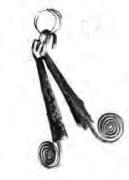
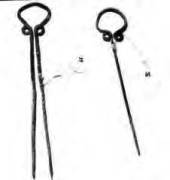 The
name of current Dalmatia traces its origin from the Illyrians tribe
Dalmatae.
They were the largest Illyrians tribe in the region, the other two
nearby tribes being Daors and Ardiaei. The tribes lived organized
in smaller units connected with family ties. That was dictated in
part by the mountainous terrain. There are many Illyrians stone
forts and burial stone piles, 2-3 meters high and over 30 meters in
diameter
all over Imotski county. Many very rich deposits of Illyrians
artifacts were found in Postranje and
Sebišina, like the two pieces of jewelry on the left.
The
name of current Dalmatia traces its origin from the Illyrians tribe
Dalmatae.
They were the largest Illyrians tribe in the region, the other two
nearby tribes being Daors and Ardiaei. The tribes lived organized
in smaller units connected with family ties. That was dictated in
part by the mountainous terrain. There are many Illyrians stone
forts and burial stone piles, 2-3 meters high and over 30 meters in
diameter
all over Imotski county. Many very rich deposits of Illyrians
artifacts were found in Postranje and
Sebišina, like the two pieces of jewelry on the left. 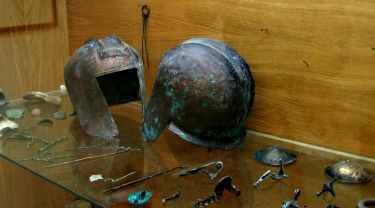
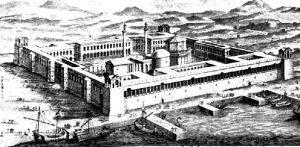 Slavic tribes.
Illyrians even gave several
Roman
emperors: Claudius II Gothicus, Aurelian, Diocletian, and Constantine
the Great. Today's Albanians are the only direct descendants of
the old Illyrians.
There is not much known written
information about the region from the Illyrian time. Few of the today's
geographic entities like mountain Mosor, Dinara, and river Sava are of
Illyrian origin.
The old Illyrian settlement names were still
reflected in the work of well known geographer Claudius Ptolomy ( ca.
A.D.
90-168) from
Alexandria who has published famous Geography in eight books. he has
collected geographic data from the then known world including the
Mediterranean region.
His "Fifth Map of Europe" contains Dalmatia with the following nearby
towns: Epetium = Stobreč, Oneum = Omiš, Oiguntium = Podstrana,
Andetrium = Muć, Delminium = Duvno,
Noabrona Col = Vid, and Salona = Solin.
Slavic tribes.
Illyrians even gave several
Roman
emperors: Claudius II Gothicus, Aurelian, Diocletian, and Constantine
the Great. Today's Albanians are the only direct descendants of
the old Illyrians.
There is not much known written
information about the region from the Illyrian time. Few of the today's
geographic entities like mountain Mosor, Dinara, and river Sava are of
Illyrian origin.
The old Illyrian settlement names were still
reflected in the work of well known geographer Claudius Ptolomy ( ca.
A.D.
90-168) from
Alexandria who has published famous Geography in eight books. he has
collected geographic data from the then known world including the
Mediterranean region.
His "Fifth Map of Europe" contains Dalmatia with the following nearby
towns: Epetium = Stobreč, Oneum = Omiš, Oiguntium = Podstrana,
Andetrium = Muć, Delminium = Duvno,
Noabrona Col = Vid, and Salona = Solin.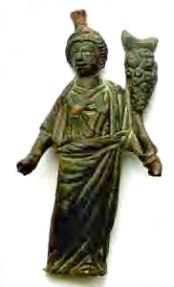
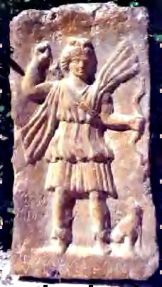 Romans have built
several settlements in the Imotski
county region, including Emanio from which the Emotha, Imota, Imotski
name has been probably derived. Another theory connects old name
Imota to italic name Aematis ( Aemate) and greek word
Hµoτa. The precise location od Emanio
has not been
determined. One theory has placed it between today's Borak and
Glavina Donja, where many Roman artifacts were discovered.
Considering the Roman habit of building settlements near water sources
Glavina is more likely, if not some other village.
Romans have built
several settlements in the Imotski
county region, including Emanio from which the Emotha, Imota, Imotski
name has been probably derived. Another theory connects old name
Imota to italic name Aematis ( Aemate) and greek word
Hµoτa. The precise location od Emanio
has not been
determined. One theory has placed it between today's Borak and
Glavina Donja, where many Roman artifacts were discovered.
Considering the Roman habit of building settlements near water sources
Glavina is more likely, if not some other village. 
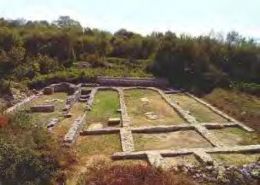
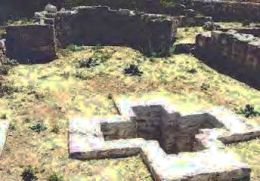
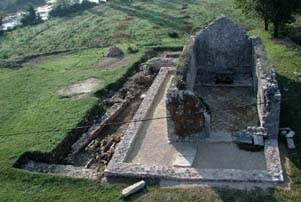 There is also a shine near Vrljika spring Opačac, built
by
Benedictines in the 6th century on a land received from Roman
emperor Justinian. The Franciscans have inherited the
property in the 14th century. The first record of their presence
in Imotski county is from 1390 in "Conforomitates vitae" by friar
Bartul from Pisa. They changed the location six more times
before settling in Imotski. The land become the property of
Francheschi family after
the Turks' defeat. The shrine was renovated and used in religious
purposes, but eventually abandoned, so it has subsequently decayed.
There is also a shine near Vrljika spring Opačac, built
by
Benedictines in the 6th century on a land received from Roman
emperor Justinian. The Franciscans have inherited the
property in the 14th century. The first record of their presence
in Imotski county is from 1390 in "Conforomitates vitae" by friar
Bartul from Pisa. They changed the location six more times
before settling in Imotski. The land become the property of
Francheschi family after
the Turks' defeat. The shrine was renovated and used in religious
purposes, but eventually abandoned, so it has subsequently decayed.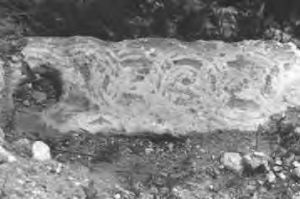


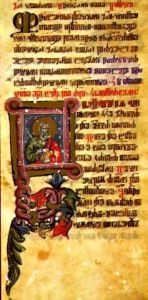 Imotski
fortress also belonged to
Herzog Stephen of Santo Saba or Hrvoje Vukčić Hrvatinić at the
beginning
of the 15th century. Hrvoje Vukčić was known for his
military successes, but it was Hrvoje
Missal from 1407 that made him better known. It is the most
decorated Croatian glagolitic document. He also left a
Imotski
fortress also belonged to
Herzog Stephen of Santo Saba or Hrvoje Vukčić Hrvatinić at the
beginning
of the 15th century. Hrvoje Vukčić was known for his
military successes, but it was Hrvoje
Missal from 1407 that made him better known. It is the most
decorated Croatian glagolitic document. He also left a 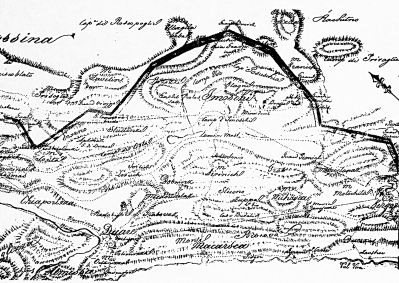 The
peace treaty from Požarevac from 1718
has determined the current
borders between Croatia and Bosnia and Herzegovina. Imotski
valley was administratively split into two parts, western controlled by
Venetians and eastern by Turks. The border around Imotski was
determined how
far cannon bullet could reach, producing semicircular
boundary. The Venetians were favoring the developed coastal
regions when it came to modernization, so
there was little
progress during their rule. They did pretty well in organizing
the county life. The biggest hurdle was how to attach immigrated
people from Bosnia and Herzegovina to land and instill property
ownership that was not guarded all the time. Outside people were
brought to administer the region, starting from
The
peace treaty from Požarevac from 1718
has determined the current
borders between Croatia and Bosnia and Herzegovina. Imotski
valley was administratively split into two parts, western controlled by
Venetians and eastern by Turks. The border around Imotski was
determined how
far cannon bullet could reach, producing semicircular
boundary. The Venetians were favoring the developed coastal
regions when it came to modernization, so
there was little
progress during their rule. They did pretty well in organizing
the county life. The biggest hurdle was how to attach immigrated
people from Bosnia and Herzegovina to land and instill property
ownership that was not guarded all the time. Outside people were
brought to administer the region, starting from 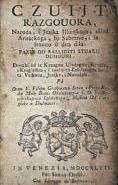 It helped that the Venetians
used Croatian or Illyrian language, how it was sometimes called.
There was only one school in the whole county in Imotski where friar
Paško Prgomet was a teacher. In
addition to a couple of
quarantines due to "cordon sanitiare" rules there was only one
hospital in the whole county in Kamen Most. There were two well
know books from that time, "
It helped that the Venetians
used Croatian or Illyrian language, how it was sometimes called.
There was only one school in the whole county in Imotski where friar
Paško Prgomet was a teacher. In
addition to a couple of
quarantines due to "cordon sanitiare" rules there was only one
hospital in the whole county in Kamen Most. There were two well
know books from that time, "
